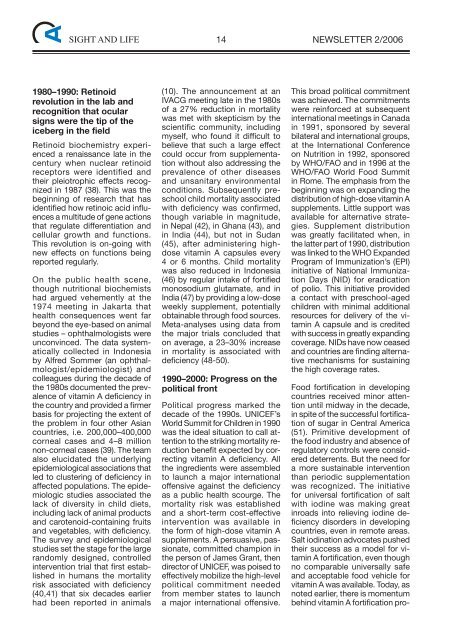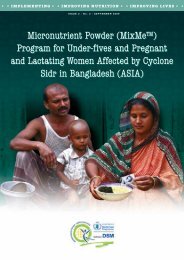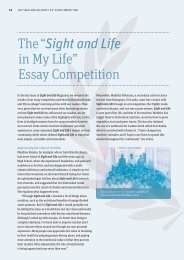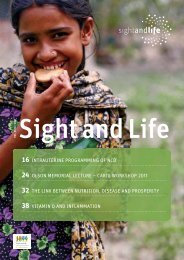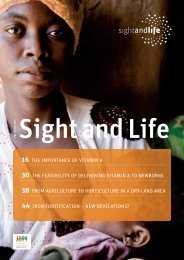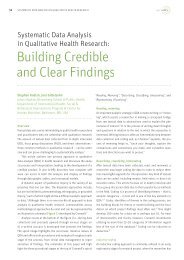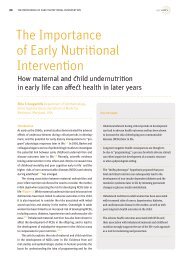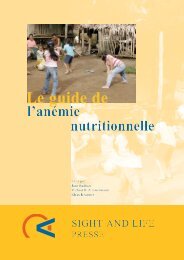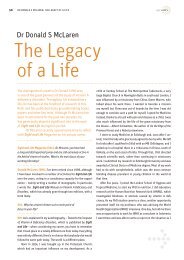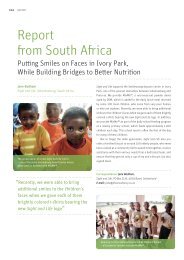Newsletter 02 2006.pdf - Sight and Life
Newsletter 02 2006.pdf - Sight and Life
Newsletter 02 2006.pdf - Sight and Life
You also want an ePaper? Increase the reach of your titles
YUMPU automatically turns print PDFs into web optimized ePapers that Google loves.
SIGHT AND LIFE 14<br />
NEWSLETTER 2/2006<br />
1980–1990: Retinoid<br />
revolution in the lab <strong>and</strong><br />
recognition that ocular<br />
signs were the tip of the<br />
iceberg in the field<br />
Retinoid biochemistry experienced<br />
a renaissance late in the<br />
century when nuclear retinoid<br />
receptors were identified <strong>and</strong><br />
their pleiotrophic effects recognized<br />
in 1987 (38). This was the<br />
beginning of research that has<br />
identified how retinoic acid influences<br />
a multitude of gene actions<br />
that regulate differentiation <strong>and</strong><br />
cellular growth <strong>and</strong> functions.<br />
This revolution is on-going with<br />
new effects on functions being<br />
reported regularly.<br />
On the public health scene,<br />
though nutritional biochemists<br />
had argued vehemently at the<br />
1974 meeting in Jakarta that<br />
health consequences went far<br />
beyond the eye-based on animal<br />
studies – ophthalmologists were<br />
unconvinced. The data systematically<br />
collected in Indonesia<br />
by Alfred Sommer (an ophthalmologist/epidemiologist)<br />
<strong>and</strong><br />
colleagues during the decade of<br />
the 1980s documented the prevalence<br />
of vitamin A deficiency in<br />
the country <strong>and</strong> provided a firmer<br />
basis for projecting the extent of<br />
the problem in four other Asian<br />
countries, i.e. 200,000–400,000<br />
corneal cases <strong>and</strong> 4–8 million<br />
non-corneal cases (39). The team<br />
also elucidated the underlying<br />
epidemiological associations that<br />
led to clustering of deficiency in<br />
affected populations. The epidemiologic<br />
studies associated the<br />
lack of diversity in child diets,<br />
including lack of animal products<br />
<strong>and</strong> carotenoid-containing fruits<br />
<strong>and</strong> vegetables, with deficiency.<br />
The survey <strong>and</strong> epidemiological<br />
studies set the stage for the large<br />
r<strong>and</strong>omly designed, controlled<br />
intervention trial that first established<br />
in humans the mortality<br />
risk associated with deficiency<br />
(40,41) that six decades earlier<br />
had been reported in animals<br />
(10). The announcement at an<br />
IVACG meeting late in the 1980s<br />
of a 27% reduction in mortality<br />
was met with skepticism by the<br />
scientific community, including<br />
myself, who found it difficult to<br />
believe that such a large effect<br />
could occur from supplementation<br />
without also addressing the<br />
prevalence of other diseases<br />
<strong>and</strong> unsanitary environmental<br />
conditions. Subsequently preschool<br />
child mortality associated<br />
with deficiency was confirmed,<br />
though variable in magnitude,<br />
in Nepal (42), in Ghana (43), <strong>and</strong><br />
in India (44), but not in Sudan<br />
(45), after administering highdose<br />
vitamin A capsules every<br />
4 or 6 months. Child mortality<br />
was also reduced in Indonesia<br />
(46) by regular intake of fortified<br />
monosodium glutamate, <strong>and</strong> in<br />
India (47) by providing a low-dose<br />
weekly supplement, potentially<br />
obtainable through food sources.<br />
Meta-analyses using data from<br />
the major trials concluded that<br />
on average, a 23–30% increase<br />
in mortality is associated with<br />
deficiency (48-50).<br />
1990–2000: Progress on the<br />
political front<br />
Political progress marked the<br />
decade of the 1990s. UNICEF’s<br />
World Summit for Children in 1990<br />
was the ideal situation to call attention<br />
to the striking mortality reduction<br />
benefit expected by correcting<br />
vitamin A deficiency. All<br />
the ingredients were assembled<br />
to launch a major international<br />
offensive against the deficiency<br />
as a public health scourge. The<br />
mortality risk was established<br />
<strong>and</strong> a short-term cost-effective<br />
intervention was available in<br />
the form of high-dose vitamin A<br />
supplements. A persuasive, passionate,<br />
committed champion in<br />
the person of James Grant, then<br />
director of UNICEF, was poised to<br />
effectively mobilize the high-level<br />
political commitment needed<br />
from member states to launch<br />
a major international offensive.<br />
This broad political commitment<br />
was achieved. The commitments<br />
were reinforced at subsequent<br />
international meetings in Canada<br />
in 1991, sponsored by several<br />
bilateral <strong>and</strong> international groups,<br />
at the International Conference<br />
on Nutrition in 1992, sponsored<br />
by WHO/FAO <strong>and</strong> in 1996 at the<br />
WHO/FAO World Food Summit<br />
in Rome. The emphasis from the<br />
beginning was on exp<strong>and</strong>ing the<br />
distribution of high-dose vitamin A<br />
supplements. Little support was<br />
available for alternative strategies.<br />
Supplement distribution<br />
was greatly facilitated when, in<br />
the latter part of 1990, distribution<br />
was linked to the WHO Exp<strong>and</strong>ed<br />
Program of Immunization’s (EPI)<br />
initiative of National Immunization<br />
Days (NID) for eradication<br />
of polio. This initiative provided<br />
a contact with preschool-aged<br />
children with minimal additional<br />
resources for delivery of the vitamin<br />
A capsule <strong>and</strong> is credited<br />
with success in greatly exp<strong>and</strong>ing<br />
coverage. NIDs have now ceased<br />
<strong>and</strong> countries are finding alternative<br />
mechanisms for sustaining<br />
the high coverage rates.<br />
Food fortification in developing<br />
countries received minor attention<br />
until midway in the decade,<br />
in spite of the successful fortification<br />
of sugar in Central America<br />
(51). Primitive development of<br />
the food industry <strong>and</strong> absence of<br />
regulatory controls were considered<br />
deterrents. But the need for<br />
a more sustainable intervention<br />
than periodic supplementation<br />
was recognized. The initiative<br />
for universal fortification of salt<br />
with iodine was making great<br />
inroads into relieving iodine deficiency<br />
disorders in developing<br />
countries, even in remote areas.<br />
Salt iodination advocates pushed<br />
their success as a model for vitamin<br />
A fortification, even though<br />
no comparable universally safe<br />
<strong>and</strong> acceptable food vehicle for<br />
vitamin A was available. Today, as<br />
noted earlier, there is momentum<br />
behind vitamin A fortification pro-


